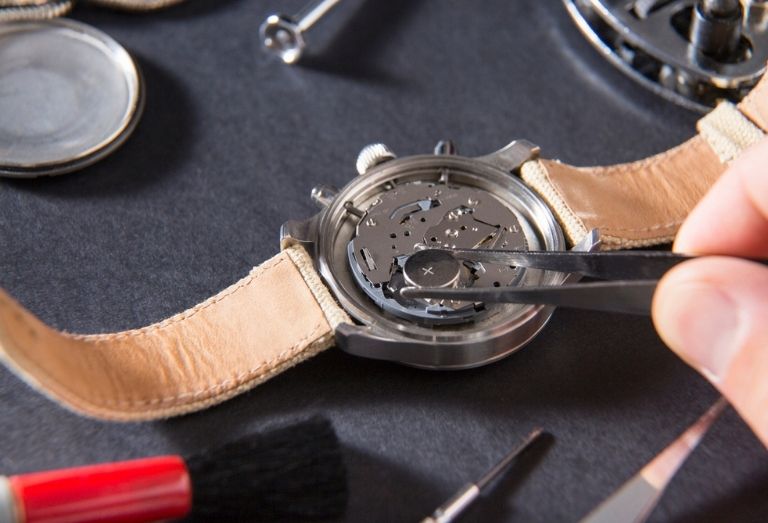Dress watches, watches for work and casual wear are usually provided with batteries to keep time. Batteries have a limited lifetime. When your watch stops, replacing the battery is one of the possible options. It is easy to learn how to do it and, consequently, to save your time and money. Besides, doing something yourself will provide you with certain satisfaction. This article provides you with a detailed guide on how to change your battery in a watch safely and efficiently.
Tools and Materials Needed
Before you start, gather the following tools to ensure a smooth process:
- Small Screwdriver Set (optional, for watches with screws on the case back)
- Case Back Opener Tool or Case Knife
- Tweezers (preferably plastic or non-metallic)
- Watch Battery (Exact Type)
- Soft Cloth or Pad (to protect the watch during work)
- Magnifying Glass (optional, for reading small numbers or handling tiny parts)
- Plastic Pry Tool (optional for battery removal)
- Lint-Free Gloves (optional, to avoid fingerprints on delicate parts)
Step-by-Step Guide to Change Your Watch Battery
Step 1: Identify the Case Back Type
Watches typically have one of the following types of case backs, which determines how to open them:
- Snap-On Case Backs: These press into place and can be pried open.
- Screw-On Case Backs: Secured by screws or a threaded cover.
- Notched Case Backs: Feature small indentations that require a case back opener.
Understanding the type of case back ensures you select the right tool for the job.
Step 2: Prepare the Workspace
- Work in a well-lit area to see small components clearly.
- Lay a soft cloth or towel on your work surface to prevent scratches on your watch.
- Remove any bracelets or straps if they obstruct access to the case back.
Step 3: Open the Case Back
For Snap-On Case Backs:
- Use a case knife or a small flat tool to carefully pry open the back.
- Look for a small indentation or gap along the edge to insert the tool.
- Gently twist the tool to lift the cover without scratching the metal.
For Screw-On Case Backs:
- Use a case back opener tool that fits into the notches around the cover.
- Turn counterclockwise to unscrew the case back.
For Watches with Screws:
- Use a precision screwdriver to remove the screws.
- Keep the screws safe in a small container to avoid losing them.
Step 4: Identify and Remove the Old Battery
Once the case back is open, locate the battery, which is usually small and round.
- Use plastic tweezers or a non-metallic tool to lift the battery. Avoid using metal tweezers, as they may cause short circuits.
- Some watches have a small clip or retaining bar that holds the battery in place. Gently lift or slide it aside.
- Take note of the battery’s orientation (which side faces up) to insert the new one correctly.
Step 5: Check the Battery Type
Look for the code printed on the old battery (e.g., SR626SW or CR2032). The replacement battery must be of the same type to ensure proper operation. If you’re unsure, consult the watch’s manual or search the model online.

Step 6: Insert the New Battery
- Place the new battery in the same orientation as the old one.
- Use plastic tweezers to position the battery without touching it directly to avoid leaving oil or dirt.
- If the battery was held by a clip or bar, carefully secure it back in place.
Step 7: Test the Watch
Before closing the case back, check if the watch is working:
- If the second hand is ticking, the battery installation was successful.
- If the watch isn’t working, ensure the battery is seated correctly and has the right polarity.
Step 8: Seal the Case Back
For Snap-On Case Backs:
- Align the cover properly with the case.
- Press the back firmly until it snaps into place. You may use a case press tool for even pressure, though it isn’t always necessary.
For Screw-On Case Backs:
- Screw the case back clockwise until it’s securely tightened.
For Watches with Screws:
- Reinsert the screws carefully, making sure they are tight but not over-tightened.
Step 9: Check for Water Resistance (If Applicable)
If your watch is water-resistant, replacing the battery on your own may compromise the seal. To restore the water resistance, you can:
- Take the watch to a professional to perform a pressure test.
- Use silicone grease on the case back seal to improve water resistance, though this isn’t a guaranteed solution.
Tips and Precautions
- Handle Small Parts with Care: Watch components are tiny and easy to lose. Keep screws and other parts in a small container while working.
- Be Gentle with Tools: Excessive force can damage the case back, battery clips, or movement.
- Note Water Resistance Warnings: If your watch is waterproof or water-resistant, replacing the battery yourself might void the warranty or compromise the seal.
- Use Original Batteries: It’s recommended to use high-quality or original batteries to ensure the longevity of your watch.
When to Visit a Professional
Not all watches are easy to open or service. You might want to consider taking your watch to a professional in the following cases:
- High-End or Luxury Watches: Brands like Rolex, Omega, or TAG Heuer often require specialized tools.
- Smartwatches: Some digital watches have complex internal components that are hard to access.
- Complicated Movements: Watches with alarms, chronographs, or multiple complications can be tricky to handle.
- Waterproof Watches: If maintaining water resistance is essential, a professional can ensure the seals remain intact.
How Long Does a Watch Battery Last?
A typical watch battery lasts between 1 to 5 years, depending on the type of watch and its features. Watches with alarms, lights, or chronographs tend to drain the battery faster. Replacing the battery promptly ensures the watch’s internal components are not affected by a leaking or drained battery.
Conclusion
Changing a wristwatch battery at home can be a straightforward task with the right tools and a bit of patience. By following the steps outlined above, you can save time and money while keeping your watch in perfect working order. However, if your watch is complex or requires maintaining water resistance, it’s best to consult a professional. Regular maintenance, including timely battery changes, ensures that your timepiece continues to run smoothly for years to come.
With practice, replacing your watch battery will become easier, giving you confidence in handling other basic repairs. Happy tinkering!

